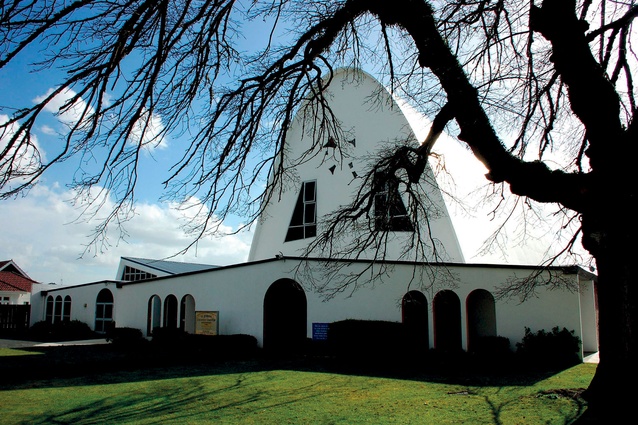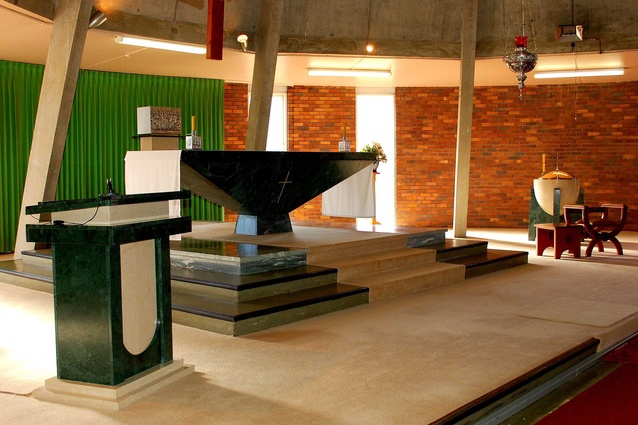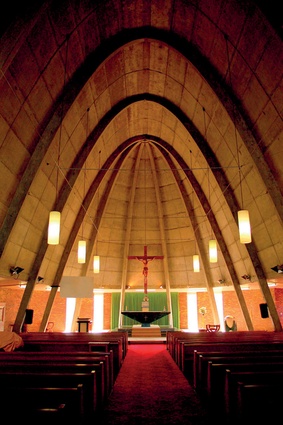Another one bites the dust
St Joseph’s Catholic Church in Morrinsville should be celebrating its 50th anniversary this year but, controversially, it has been demolished recently. The parish has resisted attempts in the past for it to be considered for an NZIA Enduring Architecture Award and it remains reluctant to comment on the church’s demise, or on what might replace it.
Matt Grant, NZIA Branch Secretary of the Waikato/Bay of Plenty Region, said, “Unfortunately the church could not be sold or moved. The land has been in church hands for over 100 years and, due to the building’s size and construction, it couldn’t be moved easily. The official line seems to be that it required earthquake strengthening. It’s disappointing to see it demolished because St Joseph’s was one of the finest churches in the Waikato.”
The church was designed in 1963 by architect Doug Angus of Hamilton firm Angus, Flood and Griffiths for the Waikato Catholic Diocese. At the time of its construction in 1964, it was described in newspaper articles as “striking” and “unusual”. Although the first design was not built, the final design chosen by the client was a distinctively modernist building with architectural and engineering features of significance. The striking design incorporated form, architecture and engineering in a simplified parabolic concrete shell.
The ceiling was vaulted with pre-stressed concrete ribs that continued to the floor forming pillars: a translation of the soaring arches of mediaeval Gothic into a modern idiom. In-situ concrete panels fitted between the arches, which, at the time, formed the biggest single poured-concrete structure in New Zealand. Irregular-shaped fenestrations on the front wall mimicked those at Le Corbusier’s famous chapel at Ronchamp in France. The glass in these fenestrations was designed and hand blown by artist Martin Roestenburg, a graduate of the Academy of Fine Arts, Munich and best known for his 14m-high statue of Our Lady of Lourdes in Paraparaumu.
St Joseph’s Church was 42m long and 19m wide and seated 450 people in its body, with a further 150 in the mezzanine choir gallery. Unusual in church architecture was the 600mm slope of the floor from the back of the church to the sanctuary. The concept was to have the mass facing the people. The original parish priest Rev J O’Connor wanted the altar brought out towards the people and not pushed back against the wall; at the time, that was typical. The inverted altar sat on a table of Milan marble nearly 3.5m wide and was designed to give correct proportion to the rest of the church. To make it a focal point, it was set in the middle of the predella with steps descending on each side.
There was a very strong Pacific form in the design of the building, some 20 years before the influences of the Pacific were formalised in New Zealand architecture. Doug Angus was particularly interested in developing places that reflected their environment within a New Zealand and Pacific context. He went on to design and build significant buildings developing these new ideas, such as the Kimiora building (1974) at Turangawaewae Marae in Ngaruawahia.
The architects, Angus, Flood and Griffiths, included John Griffiths (now 85 years old and living in Hamilton) and Douglas H Angus, now deceased, who was the brother of one of New Zealand’s most famous painters, Rita Angus. The engineer was Thomas Flood, a Fulbright Scholar and masterful engineer, also now deceased. The firm designed many regional and national NZIA Award-winning buildings which were notable for their strong, simple designs and the innovative use of materials, typically concrete.












